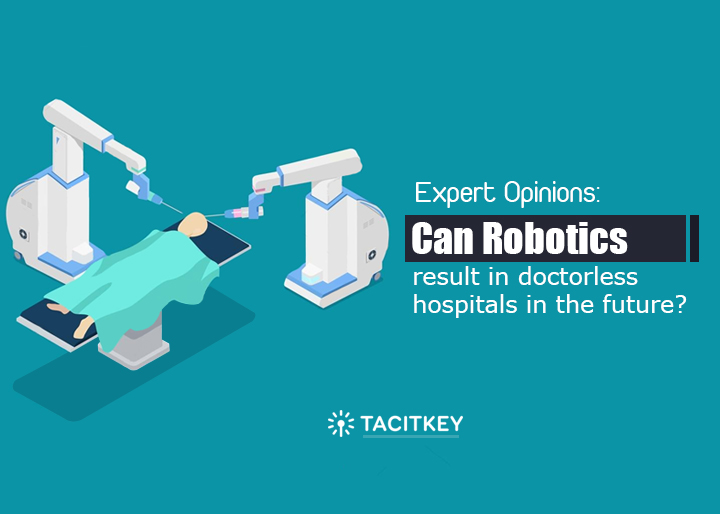- Invest in our thought leaders. Achieve your business goals. TacitKey For Business

Top 5 new Healthcare Disruptors
June 5, 2018
Tacit and explicit knowledge in public health
June 14, 2018Experts’ opinions on Robotics in Healthcare
In a world where we type jumbled numbers and letters in captchas and identify the pictures to prove to our machines and back-end processors that we are humans and not some weird robot mafia overtaking the world, the concept of replacing human doctors by programmed robots is a huge leap!
This is a very interesting topic inviting applause and simultaneously criticism from a different audience. It makes us reassess and question a variety of aspects. What will hospitals in the future look like? Who will take responsibility if things go wrong? Answers to such questions are really the ones that seem to stand in the way of change.
The ideal choice would be to choose the method that will most likely save him. But do we hand over patient care to robots?
“Of course, machines will not always get it right. But like autopilots in aircraft, and the driverless cars that are just around the corner, medical robots do not need to be perfect, they just have to be better than humans. So how long before robots are shown to perform better than humans at surgery and other patient care? It may be sooner, or it may be later, but it will happen one day,” feels Anjali Jaiprakash of The Queensland University of Technology.
Hospitals have always been the slowest in adopting latest healthcare trends. We can assume the same for Robotics and AI in healthcare. One of the important reasons for this slow change is that safety has been at the center of every decision. But the overall competition and financial pressure were finally enough to force the industry to look towards robots to do a better and much efficient job at lower costs.
The future hospitals are already here and are heading in the right direction. “What some hospitals have done in the past 10 years is recognize the potential to be more factory-like, and hence more efficient. The term “focused factories” has been used to describe some of these new hospitals that specialize in a few key procedures and that organize the workflow in a more streamlined and industrial way,” says Anjali. The idea is to free up more time, kind of like “lean processing” in manufacturing so that doctors can spend more time on complex cases.
Robots were initially considered a tool for surgery. But, the inclusion of AI in the equation means that they can best serve in diagnostics as well. The MedTech industry is abuzz with talks about a new feature in IBM’s Watson that proves just this. It can decipher possible diagnoses for a patient’s symptoms by cross-referencing it with his/her medical history. Atul Gawande an American surgeon, writer, and public health researcher wrote in his book “The Checklist Manifesto,” “the ninth edition of the World Health Organization’s international classification of diseases has grown to distinguish more than thirteen thousand different diseases, syndromes, and types of injury. That’s complexity beyond any human’s capacity to handle. But it’s not beyond a computer’s ability.”
Some experts have taken a more passive approach towards this discussion of robots replacing doctors. They feel that the future hospitals may not need doctors in such huge numbers, but the number of employed ones will not go down so drastically. “My prediction is that long before robots undermine specialists, they will undermine primary-care doctors. They will do that by specializing. They will allow the medical profession to break the conversation, the human element of the practice, from the technical diagnosis” says Ezra Klein of The Washington Post in his article titled “How robots will replace doctors”.
Doctors and nurses will work in tandem with machines on diagnosis and treatment. The concept is similar to how a librarian nowadays works with the public to find the information they want on computer systems. Robotics in healthcare can follow a similar approach. “Doctor’s offices already have people who are really good at talking to patients- the nurses, and patients like them quite a bit. They’ll speak with the patient and then they’ll go to the computer and type up what they have heard and refer the patient to the appropriate specialists or medications. The software will “know” more and catch more than most doctors could on their own, and the nurses, by virtue of being less expensive, will have more time to talk with the patients and inform the computer of what they said,” writes Ezra Klein.
It is not that doctors do not know their way around computers, but according to Ezra doctors in the years to come may need additional skill sets to stay relevant. They need a good understanding of healthcare trends and MedTech advances. They may have to learn basic programming along with their medical courses. “Programming will become the fourth literacy along with reading, writing (which may vanish) and arithmetic,” adds Anjali Jaiprakash.
But who will take responsibility when something goes wrong? This is sadly the toughest question that science has to answer.
Machines may be performing all the diagnoses and surgery, but the goal is to be involved in every process.
The simple truth here is that humans are no more perfect than machines and mistakes are something that is unavoidable in health care. It is the same as humans driving vehicles. If autonomous cars promise a significant reduction in traffic accidents, then why shouldn’t there be a reason to believe that doctorless hospitals may become a reality and improve the chances of saving lives and make healthcare more affordable to all?





